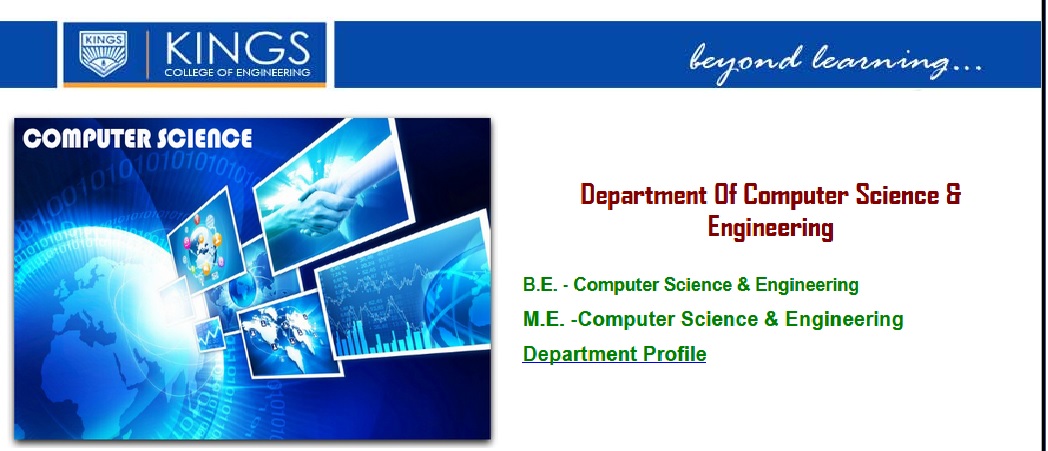CS2351 Artificial Intelligence Question Bank : kings.ac.in
Name of the College : Kings College Of Engineering
Department : Computer Science & Engineering
Subject : Artificial Intelligence
Website : kings.ac.in
Document Type : Question Bank
Download Model/Sample Question Paper : https://www.pdfquestion.in/uploads/ki…1351-AI-QB.pdf
Kings Artificial Intelligence Question Paper
UNIT I
Part A :(2 Marks)
1) What are the approaches followed to have AI?
2) Define AI.
3) Define Agent with a diagram.
Related / Similar Question Bank :
Kings College Computer Science Engineering Question Bank
Operating Systems (CS2254)
Database Management System (CS2255)
Computer Organization & Architecture (CS2253)
4) What is a rational agent?
5) What are the elements of an agent?
6) State the factors that make up rationality.
7) Distinguish omniscience and rationality.
8) What is a task environment?
9) What is a PEAS description?
10) Write a PEAS description for an automated taxi?

11) Write a PEAS description for a vacuum cleaner?
12) Write a PEAS description for a wumpus world?
13) What is agent program and agent architecture?
14) What is a software agent?
15) State the difference between utility function and performance measure?
16) State the difference between agent function and agent program?
17) Give the steps adopted by a problem solving agent.
18) What is a fringe?
19) How is problem solving algorithm performance measured?
20) What are the components that a node represents in a search tree?
PART B :
1) a. Elaborate the approaches for AI with eg. (8)
b. How is a task environment specified? (8)
2) What are the task environment natures? (16)
3) a. Describe the various properties of the task environment. (8)
b. Write PEAS description for at least four agent types. (8)
4) a. Write the environment characteristics of any four agent type. (8)
b. Explain in detail Simple reflex agent. (8)
5) Explain in detail any of the four agent structure. (16)
6) a. Explain in detail Model based reflex agent. (8)
b. Explain in detail Goal based reflex agent. (8)
7) a. Explain in detail Utility based reflex agent. (8)
b. Explain in detail learning agent. (8)
8) Explain in detail Problem solving agent. (16)
9) a. Distinguish an agent of AI and non AI program. (8)
b. Explain tree search algorithm in detail. (8)
10) Give an example and explain the toy and real world problem. (16)
11) Explain how solutions are searched by a problem solving agent. (16)
12) a. Write short notes on the following Depth First Search, breadth first search, uniform cost search, backtracking search. (8)
b. Write short notes on Iterative deepening depth first search. (8)
13) a. Write short notes on Depth limited search. (8)
b. State how repeated states are avoided and give an algorithm. (8)
UNIT II
SEARCHING TECHNIQUES
Part A : (2 Marks)
1) What is informed search?
2) What is local search?
3) What are the various types of informed search?
4) When A* is optimal?
5) What is admissible heuristic?
6) What is greedy best first search?
7) What is A* search?
8) What is SMA* search?
9) What are the types of memory bounded heuristic search?
10) What are the factors that affect the quality of a heuristic?
11) What is a local search algorithm?
12) What are the various local search algorithm?
13) What are the problems faced by a local search algorithm?
14) What are the components of a genetic algorithm?
15) What is online search and offline search?
Part B :
1) Explain any two heuristic searches in detail. (16)
2) a. Explain Hill climbing in detail. (8)
b. Explain A* search in detail. (8)
3) a. Explain simulated annealing search in detail. (8)
b. Explain Memory bounded heuristic search in detail. (8)
4) Explain any two local search algorithms in detail. (16)
5) a. Explain genetic algorithm as a local search. (8)
b. Explain online search agent working using depth first exploration. (8)
6) a. Write in detail the learning of an agent in online search method. (8)
b. Explain constraint satisfaction problem with an example. (8)
UNIT III
KNOWLEDGE REPRESENTATION
Part A : (2 Marks)
1) What are the two commitments of logic and define them?
2) What are the components of a first order logic?
3) What is the difference between the two quantifiers in the logics?
4) What is synchronic and diachronic?
5) What are casual rules?
6) What are diagnostic rules?
7) What is a model based reasoning systems?
8) What are the various steps in knowledge engineering process of a first order logic?
9) What are the various resolution strategies?
10) What is ontological engineering?
11) What is upper ontology?
12) What distinguish general purpose ontology and special purpose ontology?
13) What are categories and objects?
14) What is reification?
Part B :
1) Give the Syntax and Semantics of a first order logic in detail with an eg. (16)
2) a. Give Syntax and Semantics of a first order logic for a family domain. (8)
b. Give the Syntax and Semantics of a first order logic for Numbers, Sets, Lists domain. (8)
3) Elaborate upon the process of knowledge engineering with electronic circuits domain. (16)
4) a. Explain about unification with an algorithm in a first order logic. (8)
b. Explain in detail the concept of theorem provers. (8)
5) Explain forward chaining and backward chaining in detail for a first order definite clauses. (16)
6) Explain how categories and objects are presented in any four sets. (16)
7) Elaborate upon the ontolgy for situation calculus. (16)
8) Elaborate upon the ontolgy for event calculus. (16)